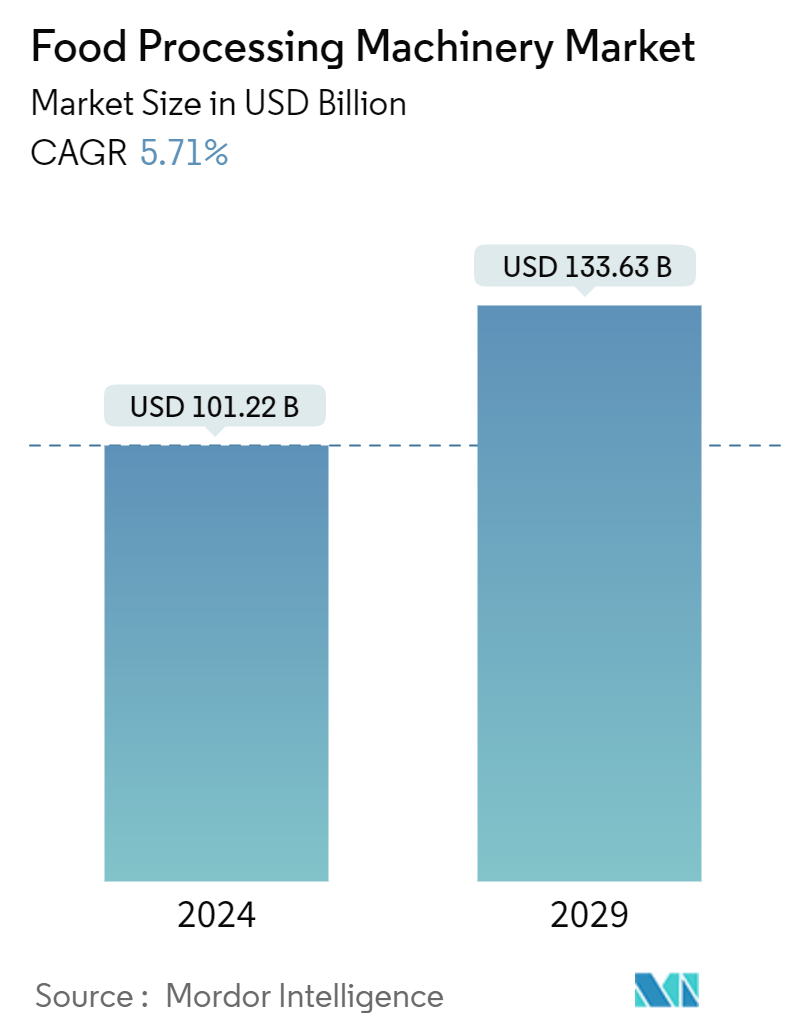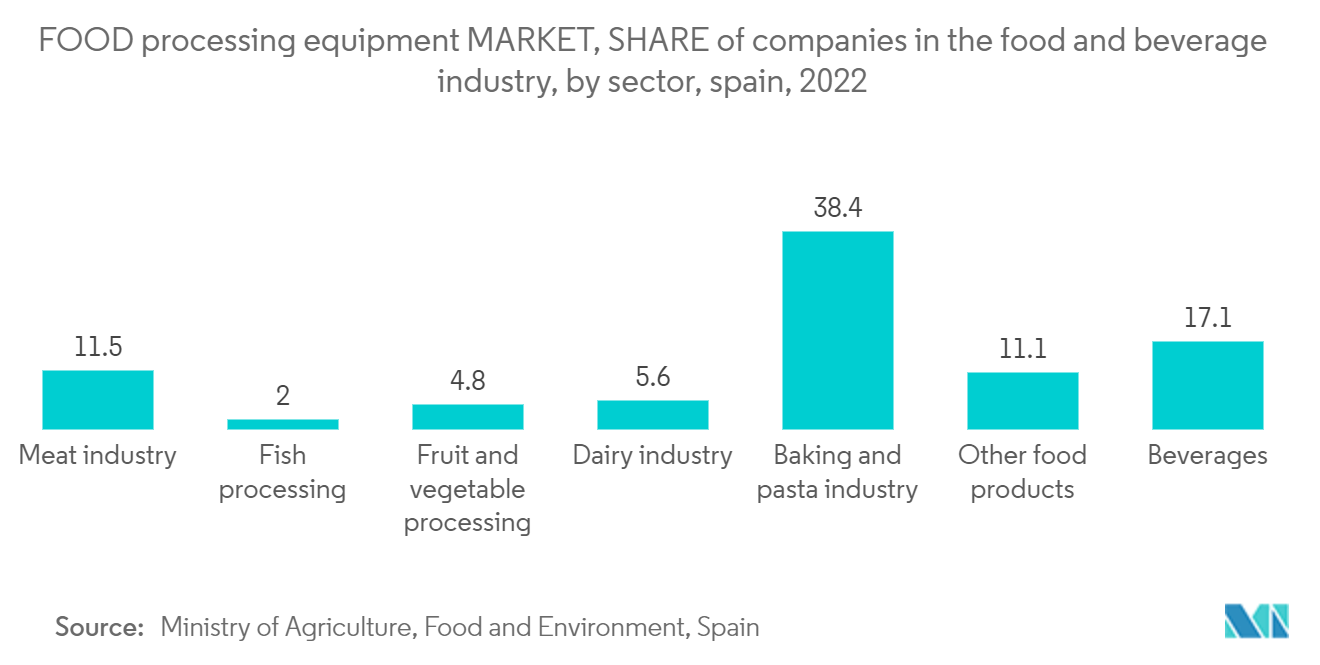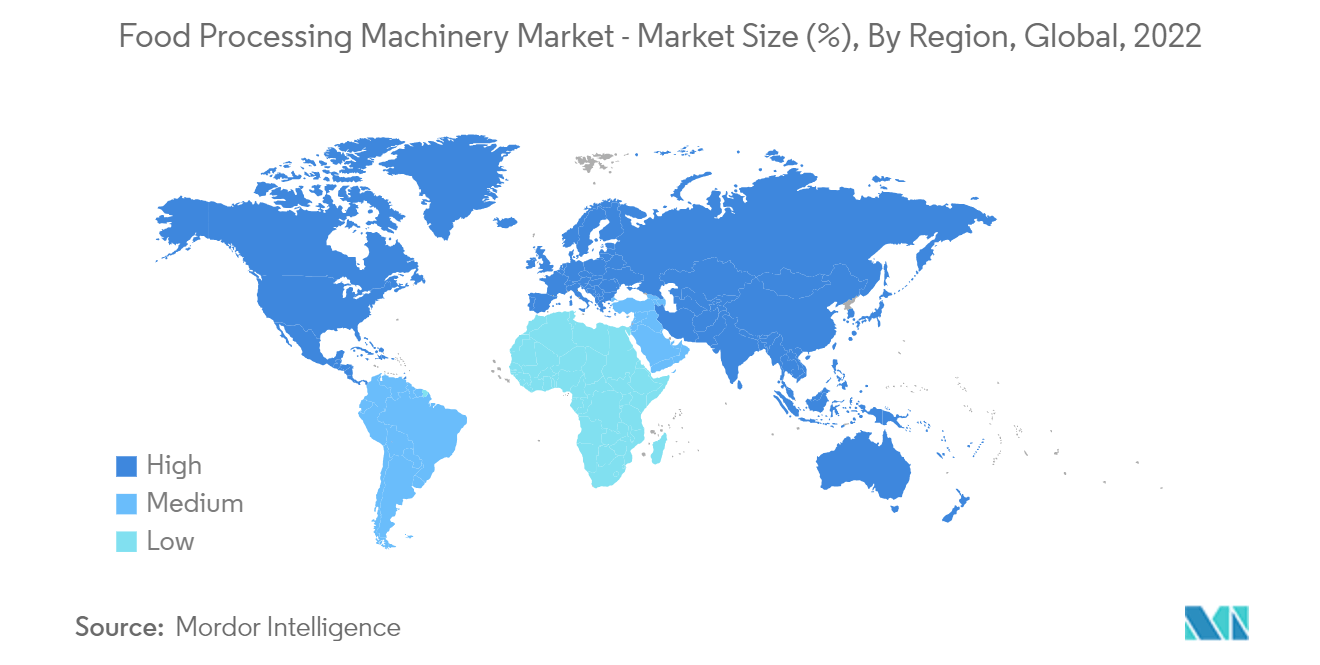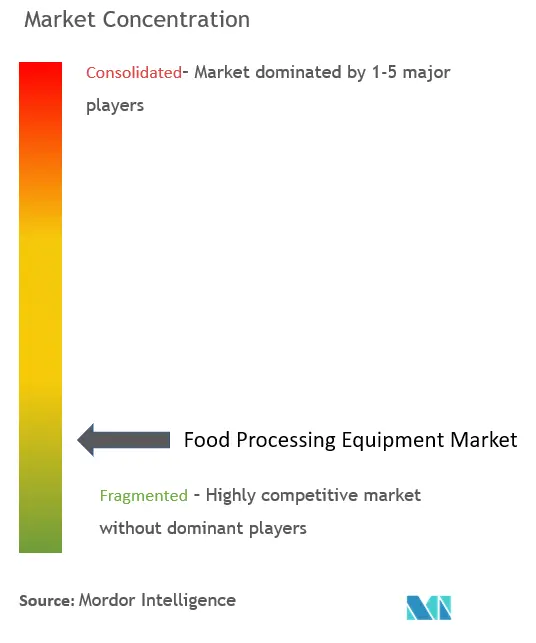Food Processing Machinery Market Size

| Study Period | 2019 - 2029 |
| Market Size (2024) | USD 101.22 Billion |
| Market Size (2029) | USD 133.63 Billion |
| CAGR (2024 - 2029) | 5.71 % |
| Fastest Growing Market | Asia Pacific |
| Largest Market | Europe |
Major Players
*Disclaimer: Major Players sorted in no particular order |
Food Processing Machinery Market Analysis
The Food Processing Machinery Market size is estimated at USD 101.22 billion in 2024, and is expected to reach USD 133.63 billion by 2029, growing at a CAGR of 5.71% during the forecast period (2024-2029).
The shift in consumer preferences toward convenient and ready-to-eat food products is driving the need for sophisticated processing equipment. Evolving consumer lifestyles are characterized by an increasing reliance on time-saving solutions and ready-to-consume food products. This paradigm shift necessitates an evolution in food processing equipment to meet the growing expectations for efficiency, variety, and quality in the production of convenience foods. Manufacturers are investing in equipment that allows for the efficient processing of a wide variety of convenience food products. The growing demand for processed foods from developing nations worldwide and government incentives, such as reimbursement on equipment, are also among the factors driving demand from the growing markets.
For instance, according to the Agricultural & Processed Food Products Export Development Authority (APEDA), the export value of processed food and products from India in 2021 amounted to USD 390.99 billion for processed vegetables and USD 780.19 for processed fruits, juices, and nuts.
Processed food demand and consumption have been steadily increasing, which is a major driver for the industry. Despite being a global phenomenon, this desire is particularly prevalent in underdeveloped countries. The food processing industry in nations like India and China has fundamentally evolved as a result of recent economic success and increased market openness to international commodities. An increase in meat eating is one of the most significant consequences of this. One of the fastest-expanding segments, especially in developing nations, is the meat processing equipment segment.
The developed markets of Western Europe, the United States, and Canada are witnessing a strong demand for processing and packaging equipment from the bakery and beverage industries. The increasing popularity of functional beverages has escalated the demand for equipment that is utilized in the production of non-alcoholic drinks and dairy-based beverage products.
Moreover,food equipment manufacturers are developing new ways of working by investing in new capabilities, like advanced data and analytics, robotics, and automation, to attract more processors. The integration of Internet of Things (IoT) technologies and smart sensors in food processing equipment is a notable trend. This enables real-time monitoring, predictive maintenance, and data-driven decision-making, enhancing overall operational efficiency. The key market players are focused on providing machinery with high efficiency to cater to the demand from food processors.
Food Processing Machinery Market Trends
Increasing Automation in Food and Beverage Processing
Advances in food processing equipment technology have led to improved efficiency, productivity, and product quality. Automation, robotics, IoT integration, artificial intelligence, and data analytics are being increasingly adopted to streamline operations, reduce labor costs, and enhance food safety and traceability. Automation is helping reduce production time while increasing output as demand and costs continue to rise. Food processors are increasingly aware of the value of data-driven insights in maximizing the utilization of raw materials, ensuring traceability and support for constant improvement, and improving food quality and safety. The robotic butchery machine, which helps speed up the process, is among the most common types of automation gear. This automated equipment also makes facilities safer since it reduces the amount of personnel handling potentially harmful tools and apparatus.
For instance, in November 2023, the University of Birmingham Enterprise launched EvoPhase. It uses evolutionary AI algorithms, coupled with simulations of particulates in systems such as industrial mixers, to evolve an optimized design for the mixing blade and the shape or size of the blending vessel. EvoPhase offers a diverse range of process equipment, including mills, dryers, roasters, coaters, fluidized beds, and stirred tanks, and is expected to result in huge cost and energy savings for the industry.
The meat, baking, and dairy segments of the market are among the major segments adopting automation in terms of processing and packaging, resulting in increased production efficiency in the market. With a significant number of players operating in the market, technical advancements in terms of automation are expected to drive the market in a positive direction over the coming years.

Europe Holds the Largest Market Share
Europe, one of the prominent regional markets, is likely to witness significant growth over the coming years owing to the growing demand for high-quality systems. France, Germany, the Netherlands, the United Kingdom, Spain, and Denmark are the important markets in Europe. Firms belonging to Europe are also major exporters of food and beverage products. France is a major exporter of food products, including dairy, meats, wines, and processed foods. To meet the growing demand for French food products in international markets, food processors require efficient and reliable equipment that can scale production to meet export requirements while maintaining product quality and consistency. For example, according to Eurostat, the volume of cheese from France reached 665.4 thousand tons in 2022, while it was 657.06 thousand tons in 2020. Similarly, according to UN Comtrade, the export of meat from sheep or goats, in fresh, chilled, and frozen forms, in France increased and reached EUR 340.61 million in 2022, registering an increase from EUR 297.29 million in 2021.
There is a growing emphasis on sustainability and environmental responsibility in the food industry. Food processors are investing in equipment that reduces energy consumption, minimizes waste, and optimizes the use of resources to achieve sustainability goals and reduce their environmental footprint. Equipment with features such as energy-efficient technologies, water recycling systems, and waste reduction measures are in demand to support sustainable food production practices. Thus, companies have started to manufacture food processing machinery with energy-efficient technology. For example, OctoFrost Processing Solutions provides energy-efficient food processing machinery, particularly in the fields of freezing and thermal processing. The company offers innovative solutions designed to optimize energy usage while maintaining the quality and integrity of food products.

Food Processing Machinery Industry Overview
The global food processing machinery market includes the presence of large regional and domestic players across different countries, with domestic companies having gained preference over multinationals with a higher market share. Some of the major players in the global food processing machinery market include JBT Corporation, Bühler AG, Krones AG, Marel, and Tetra Laval.
Food Processing Machinery Market Leaders
-
Bühler AG
-
Krones
-
JBT Corporation
-
Marel
-
Tetra Laval
*Disclaimer: Major Players sorted in no particular order

Food Processing Machinery Market News
March 2024: GEA launched a real-time monitoring solution for food processing technology at the Anuga FoodTec trade show, scheduled to take place in Cologne, Germany, from March 19 to 22, 2024. The solution has been designed to support all food processing and packaging plants in achieving key production goals, including maximizing machine availability, minimizing downtime, preventing unplanned shutdowns, and managing resources efficiently.
December 2023: Başak Traktör acquired Buhler Industries, along with FarmKing. Additionally, the shares to be acquired by Başak Traktör represent approximately 97% of all the outstanding shares.
November 2023: Anko Food Machine Co. Ltd expanded its product portfolio by launching the HLT-700U Multipurpose Filling and Forming Machine. According to the company, the machine is equipped with a new filling system that can process a wide range of both cooked and raw ingredients to make dumplings and other products.
Food Processing Machinery Market Report - Table of Contents
1. INTRODUCTION
- 1.1 Study Assumptions and Market Definition
- 1.2 Scope of the Study
2. RESEARCH METHODOLOGY
3. EXECUTIVE SUMMARY
4. MARKET DYNAMICS
-
4.1 Market Drivers
- 4.1.1 Increasing Demand for Processed Food Products
- 4.1.2 Technological Advancements Supporting Market Growth
-
4.2 Market Restraints
- 4.2.1 Increasing Cost of Production Due to Rise in Energy and Labor Cost
-
4.3 Porter's Five Forces Analysis
- 4.3.1 Threat of New Entrants
- 4.3.2 Bargaining Power of Buyers/Consumers
- 4.3.3 Bargaining Power of Suppliers
- 4.3.4 Threat of Substitute Products
- 4.3.5 Intensity of Competitive Rivalry
5. MARKET SEGMENTATION
-
5.1 Type
- 5.1.1 Processing Machinery and Equipment
- 5.1.2 Packaging Machinery and Equipment
- 5.1.3 Utilities
-
5.2 Application
- 5.2.1 Dairy and Dairy Alternatives
- 5.2.2 Meat/Seafood and Meat/Seafood Alternatives
- 5.2.3 Bakery and Confectionery
- 5.2.4 Beverages
- 5.2.5 Fruits, Vegetables, and Nuts
- 5.2.6 Other Applications
-
5.3 Geography
- 5.3.1 North America
- 5.3.1.1 United States
- 5.3.1.2 Canada
- 5.3.1.3 Mexico
- 5.3.1.4 Rest of North America
- 5.3.2 Europe
- 5.3.2.1 United Kingdom
- 5.3.2.2 Germany
- 5.3.2.3 France
- 5.3.2.4 Russia
- 5.3.2.5 Italy
- 5.3.2.6 Spain
- 5.3.2.7 Rest of Europe
- 5.3.3 Asia-Pacific
- 5.3.3.1 India
- 5.3.3.2 China
- 5.3.3.3 Japan
- 5.3.3.4 Australia
- 5.3.3.5 Rest of Asia-Pacific
- 5.3.4 South America
- 5.3.4.1 Brazil
- 5.3.4.2 Argentina
- 5.3.4.3 Rest of South America
- 5.3.5 Middle East and Africa
- 5.3.5.1 South Africa
- 5.3.5.2 Saudi Arabia
- 5.3.5.3 Rest of Middle East and Africa
6. COMPETITIVE LANDSCAPE
- 6.1 Most Adopted Strategies
- 6.2 Market Share Analysis
-
6.3 Company Profiles
- 6.3.1 Anko Food Machine
- 6.3.2 Buhler AG
- 6.3.3 GEA
- 6.3.4 Krones AG
- 6.3.5 Tetra Laval
- 6.3.6 Atlas Pacific Engineering Co. Inc.
- 6.3.7 Bean (John) Technologies Corp.
- 6.3.8 Hosokawa Micron Corp.
- 6.3.9 Nichimo Co. Ltd
- 6.3.10 Satake Corp.
- 6.3.11 Spx Corp.
- 6.3.12 Tomra Systems ASA
- *List Not Exhaustive
7. MARKET OPPORTUNITIES AND FUTURE TRENDS
** Subject To AvailablityFood Processing Machinery Industry Segmentation
The food processing machinery market is a large and complicated market that includes all of the machines and equipment used in commercial food production and packaging. The global food processing machinery market is segmented by type, application, and geography. By type, the market studied is segmented into processing machinery and equipment, packaging machinery and equipment, and utilities. By application, the market studied is segmented into dairy and dairy alternatives, meat/seafood and meat/seafood alternatives, bakery and confectionery, beverages, fruits, vegetables and nuts, and other applications. The report also provides an analysis of the emerging and established geographical regions by covering regions such as North America, Europe, Asia-Pacific, South America, and the Middle East and Africa.
The report offers market size and forecasts in value in USD terms for the abovementioned segments.
| Type | Processing Machinery and Equipment | |
| Packaging Machinery and Equipment | ||
| Utilities | ||
| Application | Dairy and Dairy Alternatives | |
| Meat/Seafood and Meat/Seafood Alternatives | ||
| Bakery and Confectionery | ||
| Beverages | ||
| Fruits, Vegetables, and Nuts | ||
| Other Applications | ||
| Geography | North America | United States |
| Canada | ||
| Mexico | ||
| Rest of North America | ||
| Geography | Europe | United Kingdom |
| Germany | ||
| France | ||
| Russia | ||
| Italy | ||
| Spain | ||
| Rest of Europe | ||
| Geography | Asia-Pacific | India |
| China | ||
| Japan | ||
| Australia | ||
| Rest of Asia-Pacific | ||
| Geography | South America | Brazil |
| Argentina | ||
| Rest of South America | ||
| Geography | Middle East and Africa | South Africa |
| Saudi Arabia | ||
| Rest of Middle East and Africa |
Food Processing Machinery Market Research FAQs
How big is the Food Processing Machinery Market?
The Food Processing Machinery Market size is expected to reach USD 101.22 billion in 2024 and grow at a CAGR of 5.71% to reach USD 133.63 billion by 2029.
What is the current Food Processing Machinery Market size?
In 2024, the Food Processing Machinery Market size is expected to reach USD 101.22 billion.
Who are the key players in Food Processing Machinery Market?
Bühler AG, Krones, JBT Corporation, Marel and Tetra Laval are the major companies operating in the Food Processing Machinery Market.
Which is the fastest growing region in Food Processing Machinery Market?
Asia Pacific is estimated to grow at the highest CAGR over the forecast period (2024-2029).
Which region has the biggest share in Food Processing Machinery Market?
In 2024, the Europe accounts for the largest market share in Food Processing Machinery Market.
What years does this Food Processing Machinery Market cover, and what was the market size in 2023?
In 2023, the Food Processing Machinery Market size was estimated at USD 95.44 billion. The report covers the Food Processing Machinery Market historical market size for years: 2019, 2020, 2021, 2022 and 2023. The report also forecasts the Food Processing Machinery Market size for years: 2024, 2025, 2026, 2027, 2028 and 2029.
Food Processing Machinery Industry Report
Statistics for the 2024 Food Processing Machinery market share, size and revenue growth rate, created by Mordor Intelligence™ Industry Reports. Food Processing Machinery analysis includes a market forecast outlook 2029 and historical overview. Get a sample of this industry analysis as a free report PDF download.



